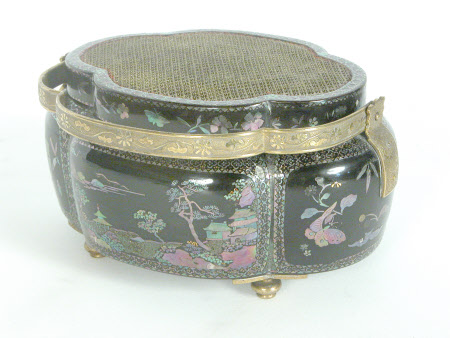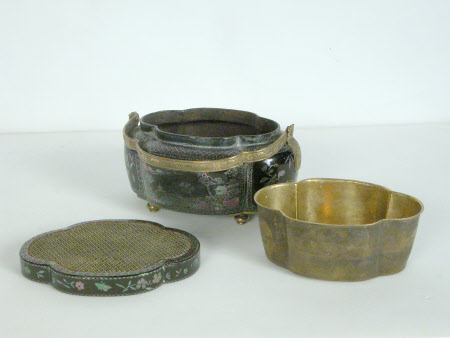Incense burner
Category
Objets de vertu
Date
1730 - 1799
Materials
Ceramic
Measurements
88 x 146 mm; 170 mm (Length)
Place of origin
Japan
Order this imageCollection
Charlecote Park, Warwickshire
NT 532434.1
Summary
Hand warmer, lacquered metal inlaid with mother-of-pearl, of elongated lobed shape and with vertically curved walls, and with a gilded, hinged handle attached to the two narrow sides. Possibly made in Yangzhou or Suzhou in the Jiangnan region of central China, probably mid or second half eighteenth century. The sides are decorated in mother-of-pearl on black lacquer with rectangular panels containing landscapes and vignettes of plants and butterflies, against a small-scale textile-inspired geometric pattern. It contains a gilded metal liner, the lid covered with fine metal mesh and with a metal panel pierced with foliate and floral shapes on the inside. The gilded metal ball feet were probably added in Europe. For another, closely related hand warmer at Charlecote Park see NT 532433.
Full description
This portable, functional and decorative object was popular in seventeenth and eighteenth-century China and Japan. The technique of mother of pearl inlay was developed in Yangzhou, China, and is representative of Chinese court taste (i). This hand warmer, and a similarly shaped companion (NT 532433), was bought by George Hammond Lucy (1789-1845) at the Fonthill Abbey sale in 1823. The sale was for the collection belonging to William Thomas Beckford (1760-1844). Beckford, a collector of luxurious objects, was also an absentee enslaver and plantation landlord. Through the wealth gained from Black enslaved labour, he acquired items for his collection and built Fonthill Abbey. Through mismanagement, lawsuits and the decline in sugar profitability, Beckford lost his fortune and sold the abbey and its contents in 1822 (ii). Originally intended as an auction, the whole estate was instead privately sold. The new owner arranged another auction of the collection in 1823 where George Hammond Lucy purchased this hand warmer (iii). (i) Emile de Bruijn, Borrowed Landscapes, (Philip Wilson Publishers, 2023), pp. 142-143. See Jonathan Hay, Sensuous Surfaces: The Decorative Object in Early Modern China, London, Reaktion Books, 2010), p. 319 (figs. 183–4), for lacquer presentation boxes inlaid with mother-of-pearl in a similar style, in the Shanghai Museum; and p. 356 (fig. 209), for a partially gilded copper hand warmer dated to the first half of the seventeenth century. And see a similarly lobed metal hand warmer decorated in gold on black and red lacquer, dated to the Qianlong reign (1736–95), in the Palace Museum, Beijing, inv. no. 00113194. (ii) See Boyd Alexander, (trans. and ed.). Life at Fonthill 1807-1822 With Interludes in Paris and London. From the Correspondence of William Beckford, (London: Rupert Hart-Davis, 1957); England’s Wealthiest Son: A Study of William Beckford, (London: Centaur Press Lt., 1962) (iii) Caroline Dakers ‘The break-up of the Fonthill estate’ in Dakers (ed.), Fonthill Recovered: A Cultural History, (London: UCL Press, 2018), pp. 97-98
Provenance
Acquired in 1823 at the Fonthill sale, page 131, 'The Lucys of Charlecote' by Mary Elizabeth Lucy (1803-1890), dated 28th Nov 1861.

